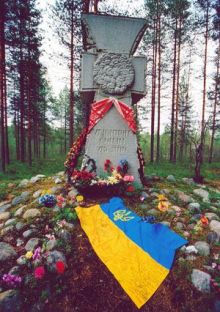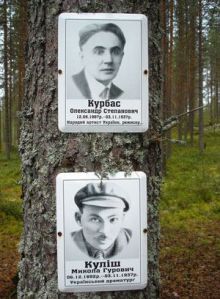For quite a while our newspaper has been holding cultural and educational actions (not to be confused with campaigns) to celebrate certain memorial years, associated with landmarks in the lives of outstanding Ukrainians who suffered unfair oblivion due to deliberate perversions of history. Our readers will remember that The Day declared 2009 the year of Hetman Ivan Mazepa, 2010 was the year of Prince Ostrozky (to celebrate the 500th anniversary of the battle at Orsha, where one of the brilliant descendants of this family, Prince Vasyl-Kostiantyn Ostrozky, totally defeated the army of the Great Prince Vassily III of Muscovy, and commemorate the huge role the Ostrozky princes played in the spread of education in Ukraine). But what are the highlights of the new year?
2012 is rich in all manner of anniversaries and memorable dates, associated with special events in Ukraine’s history. Suffice it to recall the 650th anniversary of the battle at Syni Vody (when the joint Ukrainian-Lithuanian army led by Prince Olgerd defeated the Mongol-Tatar horde, and Ukrainians played a crucial role in securing the victory), the 70th anniversary of the Ukrainian Insurgent Army, UPA, or the 200th birthday anniversary of Aleksandr Herzen, a great Russian thinker and one of the most honest publicists. However, we decided to make a special accent on the 75th anniversary of the shootings of Ukrainian intellectuals at Sandarmokh. Making 2012 the Year of “Sandarmokh List” is not a mere sign of mourning, but also a meaningful image and symbol of remembrance policy in the overcoming of our totalitarian past. To perpetuate our great past and to overcome our complicated past we have already declared the Year of Mazepa and the Year of Ostrozky. These actions have proven to be quite productive: more and more people are finding out about our true history.
Most Ukrainians associate the new year with the European Soccer championship, and this is absolutely normal. We, too, are going to cheer for our national team and support our country’s efforts as one of the hosts of the event. Moreover, Den’s English-speaking digest, The Day, which comes out twice a week, helps fill the lacuna in the quality English-speaking media resources and offers a fair, undistorted perspective of events, including those pertaining to Ukraine’s history which, as a matter of fact, is the history of overcoming. Declaring 2012 the Year of “Sandarmokh List,” we will first and foremost speak about the Ukrainian experience in overcoming.
Seventy-five years ago, right during the November holidays (it was actually the 20th anniversary of the “Great October Socialist Revolution”) the Ukrainian nation suffered a terrible blow. That was when more than a thousand people were destroyed, the intellectuals who were the nation’s protective “ozone layer.” Among them were Mykola Zerov, Mykola Kulish, Valerian Pidmohylny, and Les Kurbas (whose 125th birthday anniversary we will also celebrate this year). Their execution, on orders from Stalinist “troikas” [NKVD commissions of three persons who convicted people without trial. – Ed.], was a terrible crime against the future of the nation. The consequences of this atrocity lay outside the realm of our comprehension even today.
A humanist, pro-European, high culture, aiming at the national liberation of Ukraine and spiritual liberation of all the individuals comprising the nation, is a conditio sine qua non for the development and, moreover, survival of any nation. The people, tortured to death in Karelia and Solovki 75 years ago, were the embodiment of this kind of culture. We must remember: there was an entire “Sandarmokh List” comprising more than 1,000 persons. All were executed.
The Day is going to publish materials concerning the “Sandarmokh List,” its consequences, and a broader antitotalitarian struggle of the Ukrainian intellectuals, throughout this year. We invite the journalists and scholars, who have already done a lot by highlighting this topic to get public attention, to join in. Everybody else is also welcome.
However, there is another anniversary, this time an optimistic one, which makes this year important for The Day. Ten years ago the book Ukraina Incognita was published, which gave its name to an entire series of The Day’s Library. This collection of articles on local history was published as many as five times (in 2002, 2003, 2004, 2005, and 2007). The total number of printed copies of Ukraina Incognita (in Ukrainian and Russian) is nearly 13,000. Now we are planning a 6th edition. Overall, over the past decade (which for The Day’s authors and readers has become the decade of history and self-knowledge) we published more than 65,000 copies of books from our library series.
We will dwell on the origin, establishment, and consequences of The Day’s Library later. At the moment, The Day has asked our experts and regular authors to share their opinion about why it is important for Ukraine to speak about the “Sandarmokh List” today.
COMMENTARIES
Volodymyr PANCHENKO, Ph.D. in Philology professor:
“It is very important, to remind Ukraine (and not only it alone) of 1937. However, there can be various ways to commemorate 1937, perhaps the year of the world’s largest tragedies. I find the idea of looking at the tragedy of the 1930s, the destruction of a nation by a totalitarian regime, from the perspective of a certain place and certain, concrete fates correct and fascinating. At a certain point in time, in 2004, I visited Solovki with my friends. We also went to Sandarmokh and could feel the atmosphere of the place. On the trees at the shooting site in Sandarmokh, we put up little portraits of the people who were shot by Captain Matveiev (he would execute more than 200 inmates each day). There were very many Ukrainians among them. I will just give a few names, significant for Ukrainian culture and for our history in general: Mykola Zerov, Mykola Kulish, Valerian Pidmohylny, and Les Kurbas. This testifies to the fact that for Ukraine 1937 was but another year of genocide, of the extermination of Ukrainian intellectuals, the elite of society.
“The idea of naming 2012 the Year of ‘Sandarmokh List’ is also important because it will let the young people of today clearly see what 1937 was like. Of course, reflections on totalitarianism and the analysis of history are important in themselves, but history becomes most eloquent when it is reflected in a concrete human fate: the fates of Solovki prisoners, those who were killed by the communist regime at Sandarmokh.”
Yurii SHCHERBAK, Ambassador Extraordinary and Plenipotentiary of Ukraine:
“Announcing 2012 to be the Year of the ‘Sandarmokh List’ is extremely urgent and symbolic, because it is not just one historical person that is getting the attention of society, but millions of Ukrainians, victims of the red terror. And of course, this is not only about the people who were killed in 1937, but about those who died during the ‘emergencies’ during the civil war in the 1920s-1930s, during the World War II, and in the post-war time. Now that the historical facts are revealed, those who have desire, eyes, and conscience to acknowledge the bitter truth about the red communist utopia, have seen that the social doctrine about building a happy future for the working class was just a cover for the ancient Black-Hundred idea created by the Russian imperial chauvinism. It was an idea that aimed at the complete destruction of the Ukrainian nation and its political sovereignty, and turning Ukraine into an obedient Little Russian colony.
“Even Ukrainian national communists, the allies of VKP(b), were ferociously executed, let alone the nationalists, people who wanted to create an independent Ukrainian state.
“Firstly, nowadays the urgency of this tragic problem is caused by the increase in the pressure of ideological followers of Stolypin and Denikin, who have KGB Colonel Putin as their role model. And secondly, by the attempt of the ruling regime in Ukraine to start political persecutions, which are being staged according to the rules of blood revenge, vendetta, as it actually happened when Stalin fought Trotsky. But the organized mechanism of persecutions may demand new victims and is a threat for the opposition as well as for those who just disagree with the decisions made by the regime. That is why it is essential for all of us to remember all the reasons and details of mass terror against Ukrainians and draw proper conclusions, so this tragedy can never happen again.”








